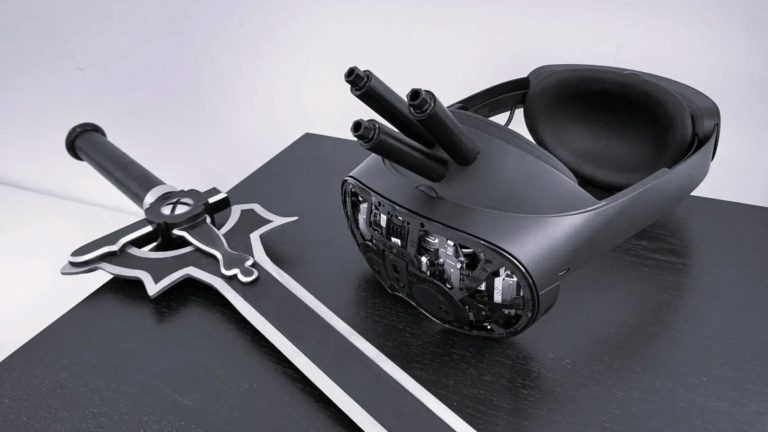
If you die in the game, you die in real life. That’s a familiar trope you’ll find across sci-fi movies, shows, and books exploring the most extreme implications of virtual reality (VR). Now, it’s a reality.
Palmer Luckey, co-founder of the VR giant Oculus, posted on his blog on November 6 that he’d created a deadly VR headset. Just like the gear from countless sci-fi works, if your character in the game dies, the headset will kill you instantly in real life. But how does it work, what led to its creation, and why is it a reality at all? Here’s a closer look.
The Origins of Deadly VR Headsets
While deadly simulations are a science fiction staple, perhaps most famously in The Matrix, Luckey cites the anime Sword Art Online as his chief inspiration. In the anime, thousands of players start playing a VR-centered online game only to find their headsets, called the NerveGear will kill them if their characters die or someone tries to remove their gear.
While Luckey’s NerveGear seems to be the first real example of an intentionally deadly VR headset, it’s not the first time video games have had real-life stakes. In 2001, artists created the PainStation, a Pong clone that dispenses electric shocks, heat, and whips to the hand when players lose. Some video game tournaments have also used electric shocks to give players a real-world stimulus for winning.
Unlike these instances, on top of being lethal, Luckey’s VR headset has no game tied to it. The gear isn’t meant to be something players actually use but an art piece. It’s a thought experiment bringing the questions raised in Sword Art Online into the real world.
How It Works
The science of how the deadly VR headset works is fairly, perhaps alarmingly, straightforward. It starts as a Meta Quest Pro, one of the most popular VR headsets available today. To make it lethal, Luckey added three explosive charges that sit at the top of the gear.
A photosensor on the inside of the headset detects when the screen flashes red at a specific frequency. Theoretical game developers can use that frequency in their game over screens, triggering the sensor, which then detonates the explosive charges.
Notably, this system is different from the fictional NerveGear that inspired it. In the anime, NerveGear uses a lethal level of microwave radiation to kill players who die in the game. Luckey points out in his blog post that he couldn’t find a way to use that approach without connecting the headset to other large machines.
Luckey’s take on the NerveGear also lacks an anti-tamper mechanism, which in the anime, stops people from taking off or destroying their headsets. However, he says he has plans for such a device.
What’s the Point of VR Gear That Can Kill You?
Luckey ends his blog post by emphasizing that the headset is “just a piece of office art.” Unlike NerveGear’s creator in Sword Art Online, this gear isn’t supposed to actually kill anyone. Instead, it serves to raise questions about VR and video game immersion.
VR has moved from a niche technology to the mainstream in relatively little time, even apart from video games. Just as rising remote work has created a rise in zero-trust security, it’s made virtual office meetings a more common sight. As these technologies play bigger roles in everyday life, some people may question how far they’ll go.
Video game developers are always looking for ways to maximize immersion, and what’s more immersing than real-life stakes? Similarly, if headsets could become harmful without people realizing it, what does that mean for metaverse-focused companies requiring VR meetings? While these possible futures are unlikely extremes, VR’s rising prominence and this art piece do spur questions.
What This Means for VR’s Future
If nothing else, this project proves that lethal VR from the likes of Sword Art Online is a real possibility, at least technologically. While developers probably won’t sell deadly headsets in the future, this device could affect the future of VR.
As developers aim to create fully immersive VR, they should keep its potential health ramifications in mind. Even if no one wants to build headsets that can kill their users, the existence of one could serve as a reminder of the extremes the technology can reach. That could cause some developers to consider the implications of their gear more carefully.
Legal regulations around the technology may also rise. Killing people is already against the law, but a real-world example of lethal VR could raise questions among lawmakers, leading to new health and safety laws. For now, though, the future remains uncertain.
Killer VR Headsets Pose Intriguing Questions
People have questioned the safety of video games for almost as long as they’ve been around. While lethal VR headsets won’t likely become the next big thing, the fact that one exists now does pose some interesting questions. In light of the possibility of deadly VR, developers, players and lawmakers alike may look at the technology more critically in the future.
 April Miller is a senior writer at ReHack Magazine and editorial contributor at AR Insider. She specializes in VR/AR, IoT, and business technology. See her work here and follow her @rehackmagazine.
April Miller is a senior writer at ReHack Magazine and editorial contributor at AR Insider. She specializes in VR/AR, IoT, and business technology. See her work here and follow her @rehackmagazine.

